Plunderchess: Pictures and a review
Plunderches is a commercial chess variant, first marketed in 2004. The publisher of the game sent me a review copy; here you can see some pictures of the set, some information on it, and an opinion.A Plunderchess set contains a set of pieces, and a set of vests. The pieces, while looking almost standard chess pieces, are shaped such that they can have these vests put over them. There are different types of vests: queen vests, rook vests, etc, and a last move vest. The king vests are only used in variants; the last move vest is not used for the variant, but can be used to take up a position after play and remember which player and which piece moved last.

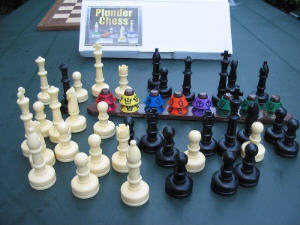
A set contains all regular chess pieces, and one additional king and one additional queen per color. There is no chess board in the set; players should use a normal chess board for that. The set contains a booklet with the rules and a short booklet of the UCSF (United States Chess Federation) with the rules of chess and information on the UCCF. The set has two vests for rooks, knights, bishops, queens, and kings, and five vests for paws, and the last move vest. The vests are on a kind of metal bar, which allows for easy storage and use.
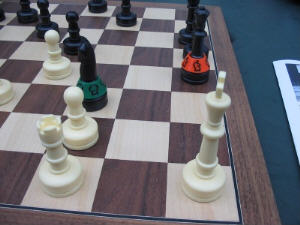

The pictures show the set, with pieces with, and without vests.

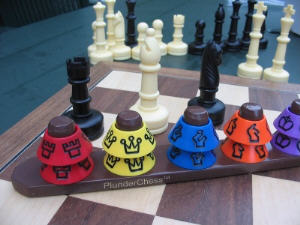
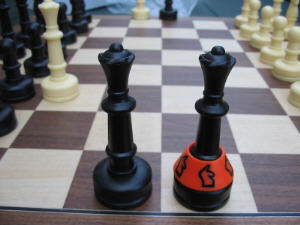

Sketch of rules
The main idea of the game is the following: when a piece takes another piece, then it gains a vest of the type of that piece. For instance, when a white pawn takes a black rook, the pawn gets a rook vest. Also, when a piece takes a piece with a vest, it can choose to take the vest from the taken piece. There are some details in the rules I'm skipping here; e.g., a piece may have only one vest at the time.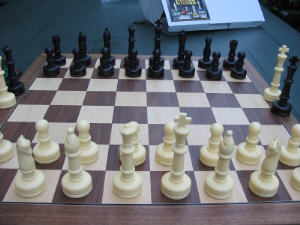


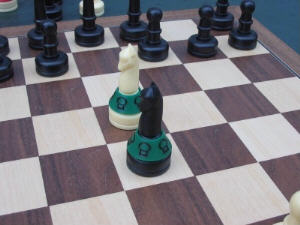

Review
I played several games of Plunderchess with two of my children (Wim, 13 years, who playes at the older youth group of the local chess club, and Annefleur, who played two years in the chess club, but now only plays with friends.) Each of us enjoyed the game a lot. The rules of Plunderchess are easy to learn, (assuming you know the rules of chess.)There are several chess variants that depart a lot from chess, and give the player the feeling that he is playing a different type of game. Plunderchess is not such a variant. The game has a real chess-feeling, but with a small twist. The opening needs a different strategy: one does not want to start a 'fair' exchange of pieces, as only the last piece that takes in a series has a vest at the end. (E.g., if a white bishop takes a black bishop, and then a black pawn takes the white bishop back, then the black pawn gets a bishop vest: definitively an advantage for black; where in standard chess this exchange would be even.) In the middle game and endgame, also interesting things can happen. I found out in the hard way how strong a rook with knight move can be. Even while one can use the vest only once, it is continuously a threat; and it also gives check to ones king.
Thus my verdict, no, our verdict: Plunderchess is a very enjoyable chess variant, liked by people that also like chess, brought to us in an attractive and well made set. Well recommended!
If you want to read more, you can look at the website of the publisher of the game: www.plunderchess.com.
Variants
The rules of Plunderchess come with two variants: one where it is allowed to switch or move vests instead of moving a piece, and one with a different setup with two kings and fewer other pieces per player. Readers of The Chess Variant Pages (chessvariants.com) can probably invest other variants as well, that can be played with this set.
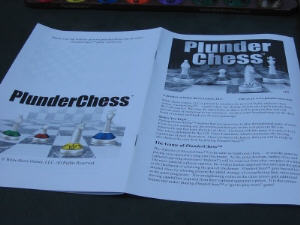
Endgame questions
I started to wonder about the endgame. A question that may be not too hard to answer(???) but looks quite intriguing to me is: can one win an endgame of king plus bishop with rook-vest versus king? I.e., one player only has a king, while the other player has a king, and a bishop that has a rook-vest. My guess is that this is still a win for the stronger player: the right to make one move as rook should really help (as the bishop easily gives check, guards lines, etc.) Similar for king plus knight with rook-vest versus king. Who analysis these, and sends us the results of the analysis?Written by Hans Bodlaender. Photo's by Hans Bodlaender, made with a Cannon Powershot A60, and modified with Microsoft PictureIt! Photo. Thanks to Wim and Annefleur Bodlaender for help with the review.
Webpage made: September 8, 2004.
